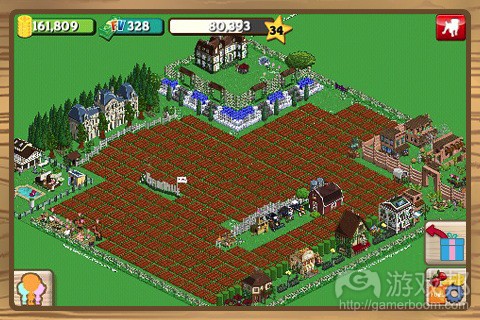如何制作一款令人上瘾的策略游戏?
作者:Steve
数周前我们讨论的是如何制作一款令人上瘾的社交游戏。我认为另外一个能够推动游戏取得成功的关键机制便是,尽可能消除游戏“停工期”的想法,并打破游戏中常规的结局流程。很多令人上瘾的策略游戏就是运用了这一机制而取得成功,如《Game Dev Story》,可以说这一机制对它们来说真的是一个非常有帮助的“武器”。在本文中我将以《Game Dev Story》,《Civilisation Revolution》和《Farmville》等游戏为例,分析如何才能在游戏中合理运用这些方法。
《Game Dev Story》
在《Game Dev Story》中,玩家的任务便是经营一家游戏工作室并创造出热门游戏。在游戏中,玩家将经历一整个游戏开发流程,即包括设计并制作自己的游戏,为其命名,并将其投放到市场中等等。
这整个流程都是按照逻辑进行,每一环节的衔接都很紧凑,所以很显然玩家在发行游戏之后会出现什么结果也是可以预测的。但是,《Game Dev Story》却给了我们一个出乎意料的结果,即采取了极其重要的一环让游戏变得更加具有吸引力。
为了知道游戏最后会有什么结果,玩家不得不等上几周的时间观看自己制作的“游戏”的销量。然而在这几周的等待过程里,玩家的开发团队却遭到了闲置。所以为了不浪费宝贵的开发时间,他们便不得不重新开始制作另一款新游戏。所以从本质上来看,在这款游戏里,玩家在意识到第一个游戏任务完成之前就已经开始执行下一轮的游戏任务,而因此打破了任务完成游戏便结束的这一自然结果。它没有那种按照逻辑进行的游戏结果,并且拥有激励玩家继续游戏的机制,他们不会觉得自己希望或者应该结束游戏。
《Civilisation Revolution》
《Civilisation Revolution》让玩家能够扮演一位历史上有名的统治者,主导整个世界。玩家在游戏中的主要任务便是建立城市,探索世界,攻打敌人。
与《Game Dev Story》一样,玩家在建立城市(游戏邦注:如组件军队或者建立防御城墙)的时候,也需要花些时间等待建造完工。就比如建城墙,就将耗费玩家10个回合的时间。那么,在这期间玩家便无事可做了,只能用自己现有的军队去攻打其他国家,或者因此而让自己陷入一些不必要的麻烦里。
因此,在建造期间,玩家将可能突然面对一些更加有趣的任务,而这些任务将需要他们建造更多的建筑物,并投入更多的注意力。建造建筑物而带来的这段“停工期”让玩家能够从新尝试一个新任务,而不会在游戏中闲置下来。
《Farmville》
《Farmville》等较为成功的社交游戏也如上述游戏一样,使用了这一方法作为其制胜的核心机制。我曾提到这些游戏取得成功的一大关键因素便是在种植庄稼和收获庄稼期间的时间拖延。这段长时间的等待不仅能让玩家有机会挑战其它任务或者展开新的旅程,同时也能够刺激玩家在庄稼成熟后重新回到自己的“田地”里收获庄稼。更特别的是,《Farmville》让玩家能够自行设定收获时间,以此让这款游戏能够更加融入玩家的社交生活中去。
如何把这一方法应用于你的游戏?
首先你需要掌握以下几大原则:
创建一个游戏流程
·这些游戏都有一个清晰的任务流程,玩家都知道自己需要采取何种行动才能继续前进。
·清晰的游戏流程让玩家能够熟悉游戏机制,让他们知道要怎么做才能在这个游戏世界里自由行进。
打破游戏末尾特定的流程,即避免完成任务就意味着游戏结束的设置
·在《Game Dev Story》中,我们很清晰地看到游戏让玩家在快要结束前“峰回路转”,即给予了他们一个新游戏任务或者让他们在一片新的领域继续探索。
·这种方法扭转了传统的游戏结局模式,让玩家在游戏中显得更加活跃,而不会轻易退出游戏。
同时这也让玩家不会认为因自己只是在重复劳作而产生无聊感。
让玩家重返游戏
通过使用一些较长的游戏流程,例如《Farmville》的做法,便让玩家会有想再次回到游戏中的理由。
让玩家能够自行决定什么时候再次回到游戏中,不会干扰他们的正常生活和工作,这样他们也不会轻易对游戏感到厌烦。
(本文为游戏邦/gamerboom.com编译,如需转载请联系:游戏邦)
How to make an addictive strategy game
by Steve
A few weeks ago we looked at how to make an addictive social game. Another mechanic that is a key element of successful games is the idea of eliminating ‘down-time’ and disrupting the flow at the end of a task. This has been applied with great success to create many addictive strategy games, such as Game Dev Story, and gives them that ‘unputdownable’ feeling. Today I’m looking at some examples of this in games such as Game Dev Story, Civ Rev and Farmville, and how these methods can be applied to your game:
There are a number of games which aim to disrupt the completion of tasks, with amazing success in controlling the psychology of the player. Here are just a few of them:
Game Dev Story
In Game Dev Story, the player’s job is to run a game studio and create hit games. The game takes the player through a ‘flow’ of designing and building your game, naming it, and releasing it.
This sequence seems to flow logically, with each section following the previous, and leads to a natural ‘conclusion’ point after a game launches. However, Game Dev Story then takes an important step which helps create it’s addictive nature.
To see how well the game did, the player have to wait weeks for the sales data to come in. However, while waiting, the player’s development team is sitting idle. So, they may as well start building another game, to avoid wasting any precious development time. Essentially, before the player’s felt the first task is ‘complete’, they start another cycle, disrupting the game’s natural ‘end point’. Hence, without a natural place to finish playing, and with an incentive to continue, the player doesn’t feel like they want to, or have the opportunity to, stop playing.
Civilisation Revolution
World-Domination-Simulator-Lite, Civilisation Revolution, allows the player to embody a famous ruler from history, and take over the world. A key part of this is building cities, exploring the globe, and attacking rivals.
Much like in Game Dev Story, to build things in cities (such as armies, or defences), the player is required to start construction then wait for construction to complete. For things like city walls, this can take up to ten turns. Ten turns in which the player is left hanging, with nothing to do but use their existing armies to attack other states, or get themselves into trouble.
Hence, by the time construction is complete, it is likely that the player will suddenly have a much more interesting scenario to deal with, which will inevitably require more construction, and your attention elsewhere. The ‘downtime’ created by waiting for construction encourages the player to start a new endeavour, and hence keeps their engagement levels up.
Farmville
Farmville, and similar successful ‘social’ games have utilised aspects from the games seen above as a core mechanic. As discussed in my social games blog post, a key aspect of these games is the delay between planting a crop, and harvesting it. This long wait not only gives players opportunity to explore other tasks and journeys within the game while waiting, but gives the player an incentive to come back to the game later when their crops are done – particularly since Farmville allows the player to choose which crops they plant based on the time to harvest, letting the game fit into their social life
How can your game replicate this?
So how can you apply these lessons to your game? Here are the key elements distilled into knowledge-flakes:
Create a flow in your game
These games all take advantage of a clear task flow, where the player knows what series of actions they need to take do to progress.
This creates familiarity with the mechanics, and lets the player know how their actions will affect the game world.
It also gives us the opportunity to….
Disrupt the flow near the end to avoid ‘down-points’
As was particularly evident in Game Dev Story, which disrupted the player as the flow ends, and gives them a new task or area to explore.
This removes natural ‘end-points’ for games, and will keep the player active in the game – making sure they don’t want to stop playing!
This also prevents the player feeling like they are just continually following repetitive actions.
Keep them coming back
Through careful use of longer-term flows, games like Farmville create reasons for the player to keep coming back.
Giving players the ability to decide how long they need to wait before acting again allows the game to work around their real-world commitments, without being obnoxious!(source:stevebromley)










































 闽公网安备35020302001549号
闽公网安备35020302001549号